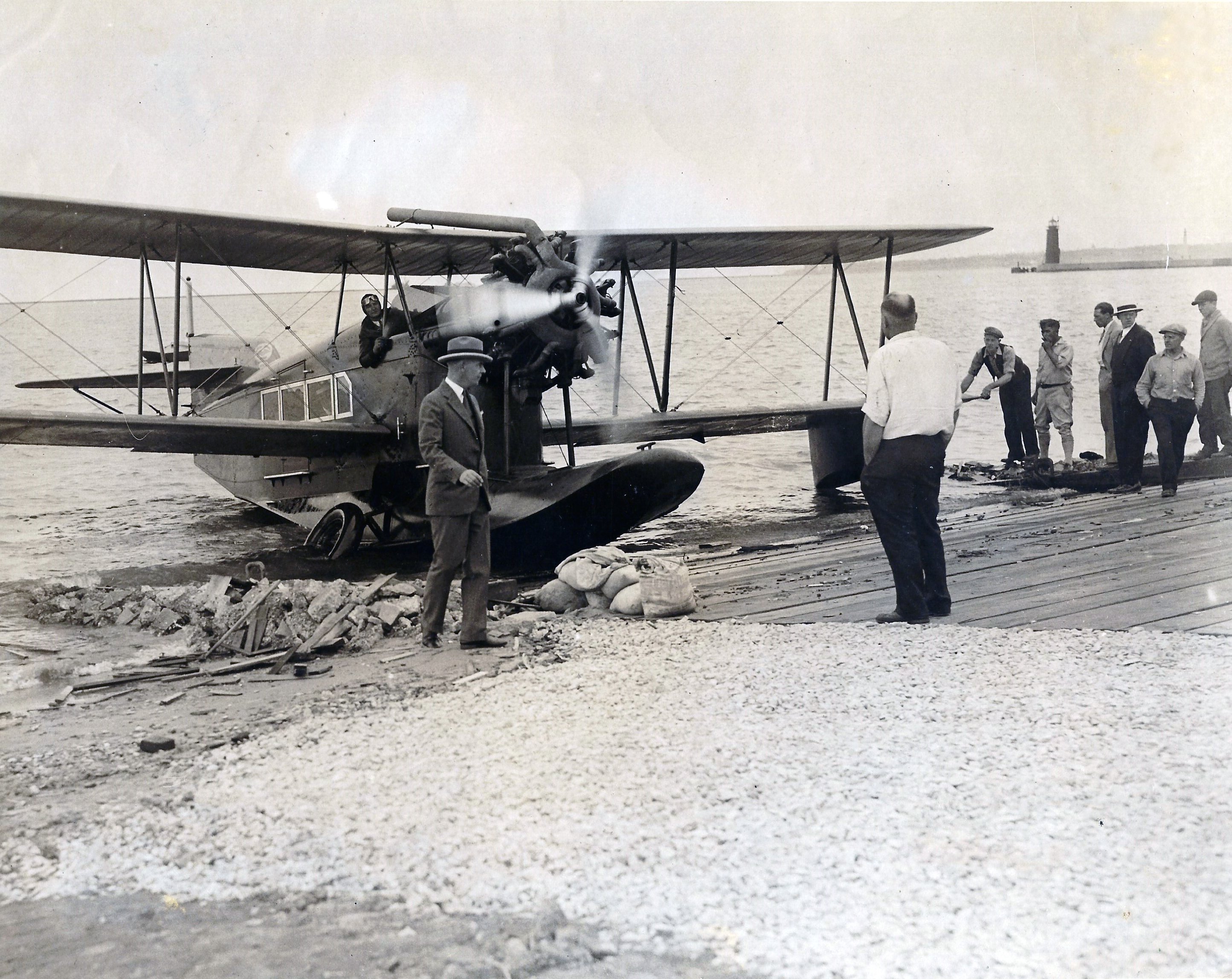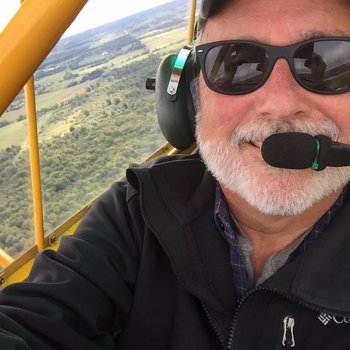
Imagine flying an open-cockpit airplane across Lake Michigan. It is January 1933, and you fly the “Bridge Across Lake Michigan” route for Kohler Aviation Corporation. The company flies the route four times daily, 12 months a year. The airline has been flying passengers and express between Milwaukee and Grand Rapids, Michigan, since September 1, 1929.
The wind swirling into the cockpit is cold and brings with it rain, sleet, and snow. While the air is cold, the lake’s surface is even colder. You know that if needed, rescue craft would be hours away as you study the wind-whipped surface of the lake. The waves increased in size several miles back and now white caps are torn from their tops by the increasing wind. You shrink down into your winter flying clothes attempting to find warmth, silently praying for an uneventful lake crossing.
Company founder, John B. Kohler, has been unsuccessful in winning a lucrative air mail contract for the over-lake route. Times are tough for everyone working for the struggling carrier.
Not every Kohler flight across Lake Michigan was successfully completed. Newspaper accounts provide details of three failed flights.
Sunday, August 28, 1932
James Benedict, Milwaukee, pilot, and Patrick Gossett, Detroit, co-pilot.
The aircraft taxied out the seaplane ramp at Maitland Field, taxied across the harbor to the entrance and began its takeoff run just before 7:30 AM. Witnesses report the airplane “hopped” three to six times during its attempt to takeoff. Reports that the aircraft took off downwind were investigated by company president John Kohler. His report of no wind conflicted with weather-bureau reports of a 12-knot wind at the time of the accident.
Pilot James Benedict describes the takeoff, “We got up about 20-feet when the airplane seemed to enter a ‘dead air’ area and would not gather forward speed.” Benedict reported that the left pontoon was smashed as the airplane struck the water. Kohler reported that the aircraft suffered more damage while under tow than during the accident.
A total of seven people were aboard the Loening C-2C Air Yacht, all employees of Kohler Aviation. Only one passenger was injured; Edmund Laskowski, Milwaukee, an aircraft mechanic, suffered a minor scalp wound.
A.R. Leclaire, a Coast Guard lookout, saw the crash occur. He sounded the alarm and a Coast Guard crew headed by Boatswain Solomon Nadeau launched into action. The aircraft was towed back to Maitland Field.
Sources: Stevens Point Journal, Stevens Point, WI; page 1, August 29, 1932
News-Record, Neenah, WI; page 1, August 29, 1932
Saturday, March 4, 1933
Pilot Roy E. Pickering and copilot Ben Craycroft
The westbound flight was observed passing over Grand Haven, Michigan, at 10:09 AM bound for Milwaukee. When Milwaukee reported the aircraft was long overdue, another Kohler Aviation aircraft departed Grand Rapids, Michigan, and began search efforts.
The incident aircraft had suffered a broken throttle rod and landed on the choppy lake surface at 10:20 AM. The crew, alone in the airplane, was only 10-miles off the Michigan coast. A strong northeast wind carried the airplane to a point about six miles offshore from Wind Point Lighthouse in Racine County, Wisconsin. The cross-lake journey lasted more than seven hours. Coast Guard crews from Milwaukee and Racine responded, finding the aircraft listing slightly due to taking on water.
Interestingly, this incident didn’t make the newspapers while Kohler Aviation Corporation did. Kohler was issued an airmail contract on March 3 for the route running Detroit-Lansing-Grand Rapids-Muskegon-Milwaukee. Kohler was acting as a subcontractor for Northwest Airways (Northwest Airlines) now Delta.
Thursday, December 28, 1933
Pilot Pat Gossett and copilot Ben Craycraft
The afternoon flight from Milwaukee taxied out at 3:10 PM and was airborne for about 30 minutes when, according to pilot Pat Gossett, “…the motor quit. I don’t know what happened, valve trouble I guess.”
Gossett and his co-pilot Ben Craycraft told their harrowing story to a newspaper reporter. “We were flying about 200 feet up. There’s not much use making altitude over the lake. The ceiling was low. I turned into the wind and landed. We knew we were in for it. It was getting dark. We both knew the ship would float and that the company would be out looking for us.”
The company did begin looking soon after the flight was reported overdue. Pilots Roy Pickering and Archie Leighton had just completed their westbound flight when they took off looking for their co-workers. They returned to Milwaukee after 7:00 PM without sighting the downed airplane. Several other aircraft were prepared to resume the search the next morning.
Gossett continued, “Waves were rolling high. We were sitting in the cabin for about five hours when the right pontoon snapped off. Then the right wing cracked. The ship started to list, and we had to get out on the left wing to balance it. We dragged the mail out after us and hung on.”
Pilot Pat Gossett and co-pilot Ben Craycraft were seasoned aviators, both serving in the military. “Way down deep, I thought we’d never see land again. The waves were hitting the plane hard. We could hear it rip and crack. I knew it wouldn’t be long before it went down,” said Gossett. He added, “Then we saw a light.”
The light that the wet, tired, and frigid crew saw was the Coast Guard cutter Escanaba. It was just before midnight when the Escanaba crew pulled Gossett and Craycraft aboard. The pilots had been on the water for more than eight hours. Coast Guard crews from all along the Wisconsin and Michigan shores had been searching for the downed airmen since receiving the report at 5:30 PM. The Escanaba had steamed more than 53 miles from its home port of Grand Haven, Michigan, during the search.
Gossett, when asked if he would fly again, responded, “I was seasick, cold, and tired. Scared? Never, I will be flying again tomorrow.”
Gossett may have flown the next day but the future for Kohler Airways was bleak and short. The company would file for bankruptcy in May 1934 and its assets, including its routes, were purchased by Pennsylvania Airlines in June 1934.
